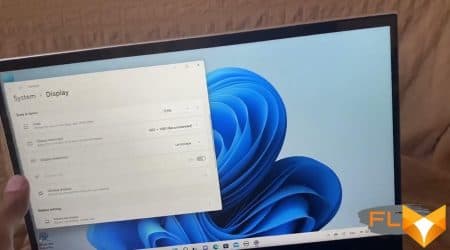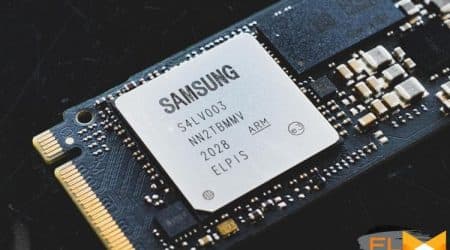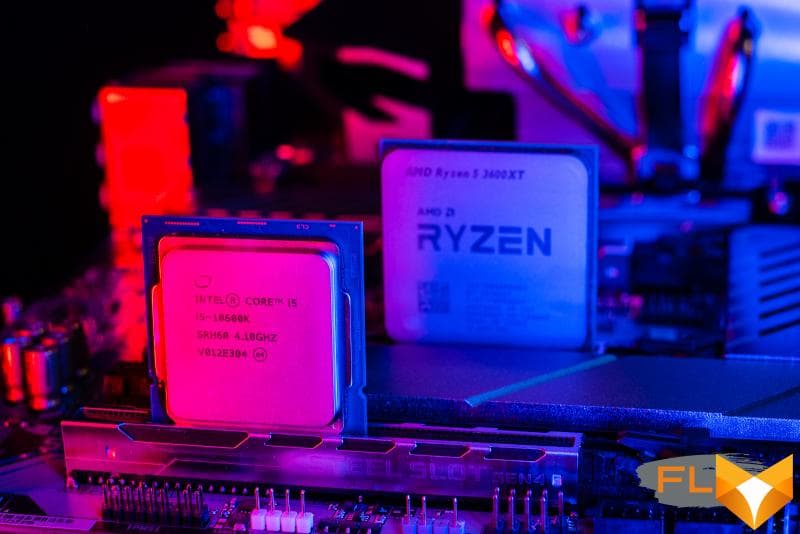


In the first half of the summer, both processor manufacturers seriously updated the range of consumer models. Intel strengthened its position with the launch of the Comet Lake family of LGA1200 Core processors of the ten thousandth series, to which AMD responded with the updated Matisse Refresh Ryzen 3000XT processors. It’s worth saying right away that both of these new products are nothing special: from the point of view of architectures and technologies, they do not offer any progress. We are talking exclusively about extensive improvements, which in general can be described as an attempt to squeeze the last juices out of existing developments. However, the result for AMD and Intel turned out to be very different.
Intel, which still continues to use the 14nm process technology (with some advantages), was able to noticeably tweak the clock speeds of its new processors, but, more importantly, this was not the end of the matter. In addition, Comet Lake processors received additional cores and computational threads, which in total allowed them to become noticeably faster than the representatives of the previous generation of Coffee Lake. True, all this acceleration revealed a side effect – a significant increase in heat dissipation of older CPU models, but it hardly surprises anyone – what you wanted from the technical process launched back in 2014.
AMD’s approach to updating the lineup turned out to be simpler. In this case, we are not talking about any processing of the design of processors, at least at the level of a semiconductor chip, the company simply took advantage of the improved quality of 7-nm silicon coming off the TSMC production line. Due to the fact that in the year that has passed since the appearance of the first representatives of the Matisse family, there has been some progress in the technical process parameters, AMD simply raised the frequencies of the older models of its CPUs. As the first tests showed, this did not give a noticeable effect, but in some situations, the fresh accelerated Ryzen 3000XT models began to look really more confident than their predecessors.
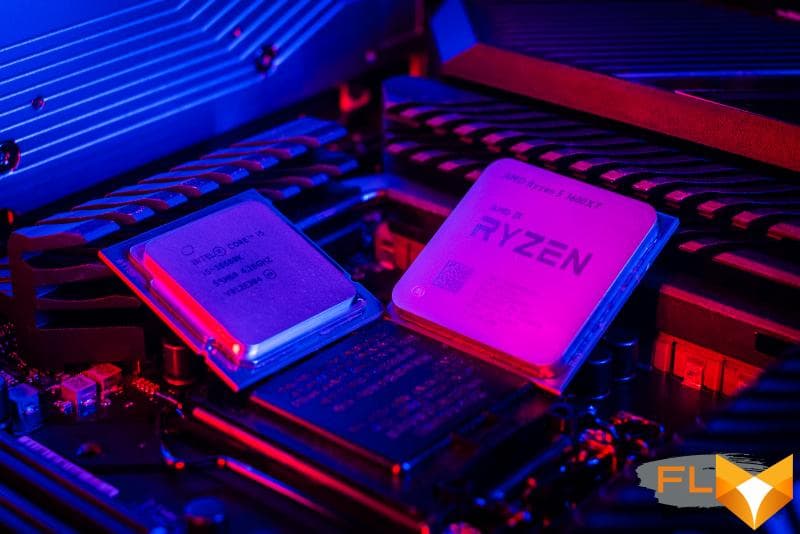
Thus, if we talk about the situation as a whole, then the appearance of Comet Lake and Matisse Refresh cannot be called some kind of significant event. They could not significantly change the landscape in the processor market. AMD has and continues to offer the most multi-core and most productive mainstream processors in the upper price segment and cheaper options in the middle. Intel, in response, appeals to gaming performance – in this respect, Ryzen has both lagged behind, and continues to lag behind the Core brand processors.
However, so far, we have tested representatives of the Comet Lake and Matisse Refresh series only on the example of processors with eight cores or more: Core i9-10900K, Core i7-10700K, Ryzen 9 3900XT and Ryzen 7 3800XT. At the same time, the situation with mid-range processors, which have six processing cores, may be somewhat different. Therefore, in order to get a better idea of the current balance of power, we decided to pay attention to the comparison of models that play in the price segment “around $250”. And in the new material we will talk about which of the older six-cores currently on store shelves looks more interesting – Ryzen 5 3600XT or Core i5-10600K.
Such a comparison is of particular interest, since six-cores, according to the opinion prevailing among advanced users, are currently considered the best choice for typical gaming builds. Six cores, especially if they are reinforced with support for multithreading technologies, are enough today for any game without exception, and even more than that, they provide a good margin for the future, allowing us to hope that systems based on Core i5 and Ryzen 5 class processors will retain its relevance for several more years.
⇡#AMD Ryzen 3600XT
Our acquaintance with the older Matisse Refresh processors turned out to be a disappointment. The Ryzen 9 3900XT and Ryzen 7 3800XT are almost identical in performance to the models with the X index that have been on the market for a long time, but at the same time, AMD decided to sell the new items at a slightly higher price. With the Ryzen 5 3600XT, the situation is generally similar: its official price is $249, while the price of the Ryzen 5 3600X has now dropped to $215.
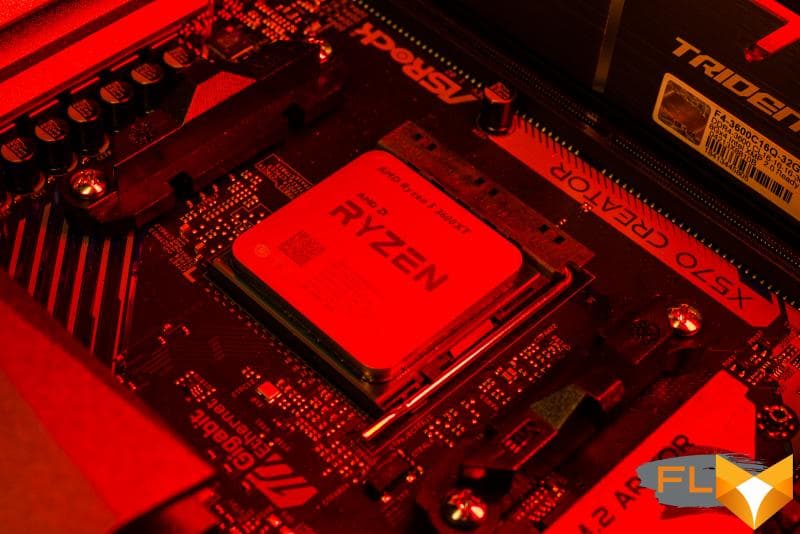
The rather hefty mark-up is weakly supported by the advantages in the specifications. From the point of view of passport characteristics, the Ryzen 5 3600XT and Ryzen 5 3600X differ only in the 100 MHz advantage of the former in the maximum turbo frequency. Everything else is identical.
| Ryzen 5 3600XT | Ryzen 5 3600X | |
|---|---|---|
| Announcement date | July 2020 | July 2019 |
| Platform | Socket AM4 | Socket AM4 |
| Technological process, mm | 7/12 | 7/12 |
| Cores/Threads | 6/12 | 6/12 |
| Frequency (nominal/turbo), GHz | 3.8-4.5 | 3.8-4.4 |
| L3 cache, MB | 32 | 32 |
| TDP, W | 95 | 95 |
| Memory | DDR4-3200 | DDR4-3200 |
| PCIe lanes | 20 × Gen4 | 20 × Gen4 |
| Integrated Graphics | No | No |
| Price | $249 | $249 |
AMD defends itself by saying that it’s not that simple and that the Ryzen 5 3600XT uses 7nm CCD chips with improved silicon, which allows them to more aggressively use the capabilities of Precision Boost 2.0 technology. Indeed, if you look at what frequencies the Ryzen 5 3600XT operates in reality (we traditionally conduct this test in Cinebench R20, varying the number of threads involved), you can see that in comparison with the Ryzen 5 3600X, the new version of the older six-core takes on 100-150 MHz higher frequencies. Moreover, this advantage is observed not only with low-threaded loads, but also where all the available CPU cores are loaded at once. In addition, with a single-threaded load, the Ryzen 5 3600XT can even go a little beyond the specifications – the maximum instantaneous frequency recorded in practice was 4.6 GHz.

Other than a higher operating frequency, the Ryzen 5 3600XT doesn’t offer any new features. As before, this processor is based on a single CCD chip with two quad-core CCX complexes, each of which has one core locked. The L3 cache, respectively, is made up of two halves of 16 MB each, and the connection between them, as well as with the I / O chiplet, where the memory controllers and PCI Express are located, is provided by the Infinity Fabric bus.

Despite factory overclocking, the Ryzen 5 3600XT, like the regular Ryzen 5 3600X, technically fits into a 95W thermal package, and its power consumption is capped at 128W. This allows AMD to package it with a Wraith Spare cooler, while all other processors from the Matisse Refresh family come without coolers and are seasoned with recommendations for using them with liquid cooling systems.
Against the backdrop of some improvement in the frequency potential of the processor itself, the usual restrictions continue to apply to the Infinity Fabric frequency in the Ryzen 5 3600XT. Its maximum speed can reach 1866-1900 MHz, and then the processor, like its predecessors, loses its stability. That is, the optimal memory mode for the Ryzen 5 3600XT, in which all parts of the “processor cores – memory” line work synchronously and at the maximum frequency, is DDR4-3733 or, if you’re lucky, DDR4-3800.
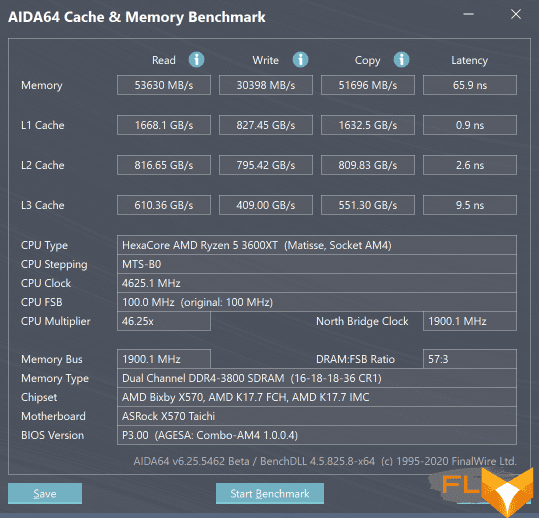
⇡#Intel Core i5-10600K
With the release of desktop processors of the Comet Lake family, Intel approached the issue of pricing more carefully than usual. And this is good news: in the absence of any technological progress, this has become perhaps their most important advantage. In fact, Intel tried to place its new processors on those steps of the price pedestal that AMD had built before. And this is especially clear just on the example of mid-range offerings: the cost of a six-core Core i5-10600K is $262, and the cost of the same processor, but without an integrated graphics core (Core i5-10600KF) is $237. This means that the Core i5-10600K is a direct competitor to the $249 Ryzen 5 3600XT.
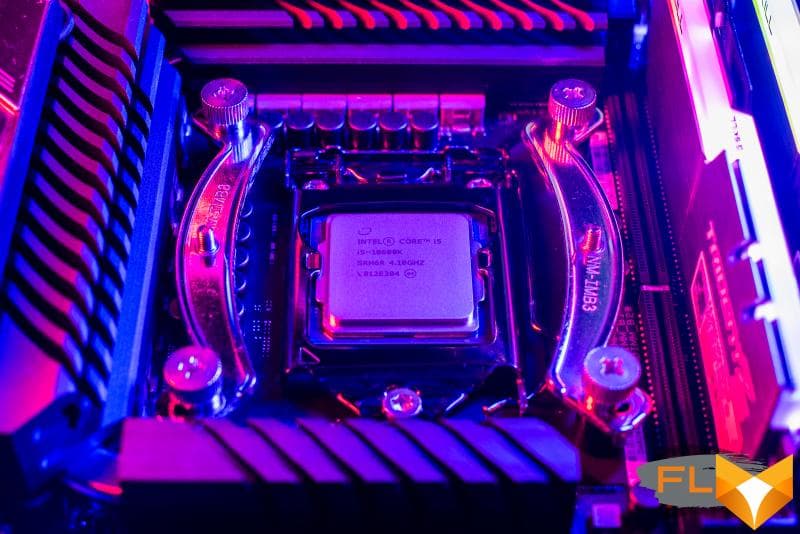
At the same time, Intel reinforced the new generation processors either with additional cores, as in the case of Core i9, or with Hyper-Threading technology and additional threads, as in the case of Core i7, Core i5 and Core i3. As a result, the Core i5-10600K in question became a 12-thread six-core processor, which approached the representatives of the Ryzen 5 series not only in price, but also in the nuclear formula.
The amplification that has taken place makes the Core i5-10600K completely different from its predecessor in the face of the Core i5-9600K. Now the older Core i5 wants to be compared in performance with the older representatives of the Core i7 series of the previous generation, which offered eight cores and eight threads, or with the flagship mass processors of the generation before last. Indeed, the 6/12 formula was first tested by Intel in the Core i7-8700K, and the Core i5-10600K is the same processor, only offering a higher clock speed.

The formal differences between the Core i7-8700K and Core i5-10600K are minimal: both have 12 MB of L3 cache, the same DDR4-2666 memory is supported, and even the integrated graphics are similar – UHD Graphics 630 with a frequency of up to 1.2 GHz. But at the same time, in Intel’s classification, the Core i7-8700K processor belongs to the Coffee Lake family, and the new Core i5-10600K is Comet Lake. Plus, they work in different platforms – LGA1151v2 and LGA1200, respectively.
| Core i5-10600K | Core i7-9700K | Core i5-9600K | Core i7-8700K | |
|---|---|---|---|---|
| Announcement date | April 2020 | October 2018 | October 2018 | October 2017 |
| Platform | LGA1200 | LGA1151v2 | LGA1151v2 | LGA1151v2 |
| Technological process, mm | 14 | 14 | 14 | 14 |
| Cores/Threads | 6/12 | 8/8 | 6/6 | 6/12 |
| Frequency (nominal/turbo), GHz | 4.1-4.8 | 3.6-4.9 | 3.7-4.6 | 3.7-4.7 |
| L3 cache, MB | 12 | 12 | 9 | 12 |
| TDP, W | 125 | 95 | 95 | 95 |
| Memory | DDR4-2666 | DDR4-2666 | DDR4-2666 | DDR4-2666 |
| PCIe lanes | 16 × Gen3 | 16×Gen3 | 16×Gen3 | 16×Gen3 |
| Integrated Graphics | Yes | Yes | Yes | Yes |
| Price | $262 | $374 | $262 | $359 |
Compared to the Core i7-8700K, the base frequency of the Core i5-10600K is 400 MHz higher, and the maximum frequency is 100 MHz higher. With a load on all cores, the Core i5-10600K can keep the frequency at 4.5 GHz, while the Core i7-8700K processor did not overclock above 4.3 GHz with a twelve-thread load. If we talk about the Core i7-9700K, then it keeps the frequency of 4.6 GHz under full load. More information about the dependence of frequencies on the load can be found in the following table.
| Maximum frequency in turbo mode, GHz | Base, GHz | ||||||||
| 1 core | 2 cores | 3 cores | 4 cores | 5 cores | 6 cores | 7 cores | 8 cores | ||
| Core i5-10600K | 4,8 | 4,8 | 4,8 | 4,7 | 4,5 | 4,5 | – | – | 4,1 |
| Core i7-9700K | 4,9 | 4,8 | 4,7 | 4,7 | 4,6 | 4,6 | 4,6 | 4,6 | 3,6 |
| Core i5-9600K | 4,6 | 4,5 | 4,4 | 4,4 | 4,3 | 4,3 | – | – | 3,7 |
| Core i7-8700K | 4,7 | 4,6 | 4,5 | 4,4 | 4,4 | 4,3 | – | – | 3,7 |
For a complete picture, one more important point cannot be ignored. By switching to a new socket – LGA1200, Comet Lake processors were able to increase their power consumption and heat dissipation. The Core i5-10600K TDP is set to 125W instead of 95W as before, and under short-term loads it is allowed to take up to 182W from the VRM of the motherboard (previously, the value of the maximum peak consumption was limited to 119W). These easings give the Core i5-10600K a much better chance of turning to full power, even if it’s running on a system where the Multi-Core Enhancements feature is disabled for some reason.
For example, when tested in Cinebench R20, the actual consumption of the Core i5-10600K fits perfectly within 100 W, even when rendering using all available threads. This means that compared to the eight- and ten-core Comet Lake, the six-core is much more economical and fits in a 125-watt thermal package with a margin, and its frequency will not be “cut off”, even if the motherboard manufacturer wants to strictly follow Intel’s recommendations.
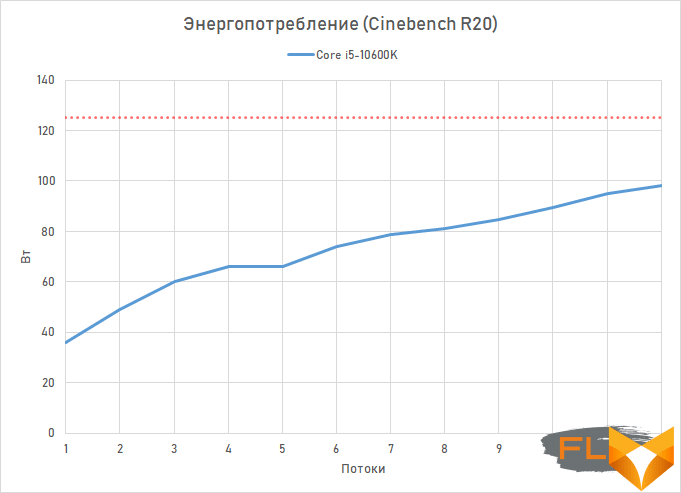
The feeling that the Core i5-10600K is closer to the Core i7-9700K and Core i7-8700K than to the older brothers of the Coffee Lake family is reinforced by another fact. In the new processors of the Core i9 and i7 series, Intel has added new types of turbo technology: Turbo Velocity Boost (auto-overclocking depending on the temperature of the processor) and Turbo Boost Max 3.0 (auto-overclocking for individual processor cores). But the Core i5-10600K does not have either technology, but only the usual Turbo Boost 2.0 turbo mode.
However, the new Core i5-10600K is still not a converted Coffee Lake. Technically, this is a true Comet Lake based on the latest Q0 stepping silicon.
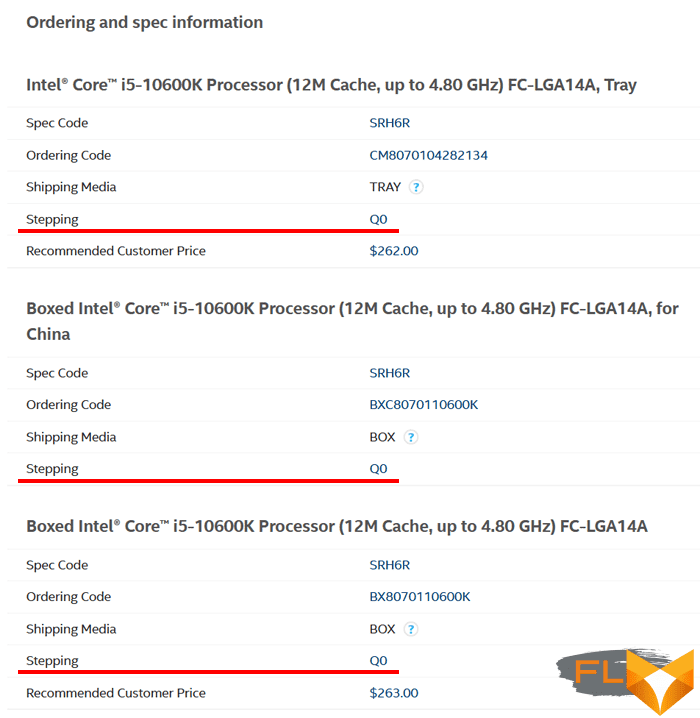
And this means that the Core i5-10600K is based on an initially ten-core semiconductor crystal, in which four cores are hardware-locked. This crystal, like in older Comet Lake processors, has a reduced thickness, and an effective thermal interface in the form of indium solder is used to remove heat to the processor heat-distributing cover. All this makes the Core i5-10600K a very interesting processor. Despite the fact that we are talking about a 14-nm chip, its operating temperatures should be lower than other Intel processors: together with an effective thermal interface, the Core i5-10600K plays into the hands of a significant surface area of the crystal – it reaches 198 mm2 , which is about a third more than the six-core Core i7-8700K.
It is curious that only the overclocker Core i5-10600K and Core i5-10600KF received a ten-core crystal among the six-core Comet Lake. These processors always use the initially ten-core stuffing of the Q0 stepping. But the younger representatives of the same Core i5 series, for the most part, receive a different silicon related to the G1 stepping. Such crystals have only six cores, moreover, they are mounted in processors using thermal paste, not solder. Thus, the advantages of the Core i5-10600K over simpler six-core processors are not only in the unlocked multiplier and overclocking capabilities.
⇡#Temperatures and power consumption
The unexpected discovery that in practice the Core i5-10600K is characterized by rather moderate consumption suggests the need for a practical comparison of the thermal and energy parameters of the older six-core AMD and Intel. Although the Ryzen 5 3600XT is manufactured on a modern 7nm process and has a TDP of 95W, it seems that the 14nm, 125W Core i5-10600K could well compete with it in power efficiency and thermal management.
All this can be clearly confirmed by the results of the test. The following graph shows the consumption of the Core i5-10600K and Ryzen 5 3600XT when rendered in Cinebench R20 when loaded with different numbers of threads and cores.
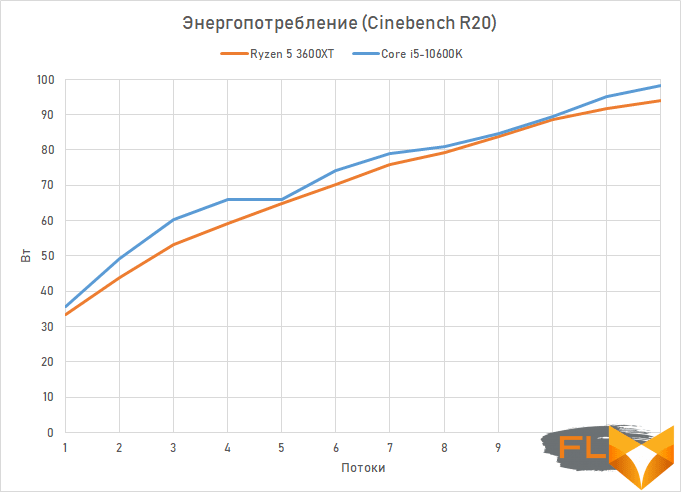
It turns out that the six-core processors from AMD and Intel, built on fundamentally different microarchitectures and manufactured using radically different technical processes, are very close in consumption in real tasks. The Core i5-10600K is almost always a little more gluttonous, but the difference in the worst case for it does not exceed 7 watts. If we talk about work when using the entire arsenal of cores and threads, then the consumption of the Core i5-10600K is 98 W versus 94 W for the Ryzen 5 3600XT.
It turns out that the claims that it has become customary to express to the energy appetites of Intel processors are valid only for older multi-core processors: Core i9-10900K and Core i7-10700K. Putting the six-core Comet Lake on a par with them is completely unfair.
Even more interesting is the situation with the temperatures of the processor chip. Here, the “thin” process technology used by AMD plays a clearly negative role. Heat dissipation from the small 74mm2 Ryzen 5 3600XT CCD chiplet is much more difficult than from the 10-core 14nm Core i5-10600K die, which is two and a half times larger. Therefore, don’t be surprised by the temperature curves below (in both cases they are built for the same Noctua NH-U14S cooler).
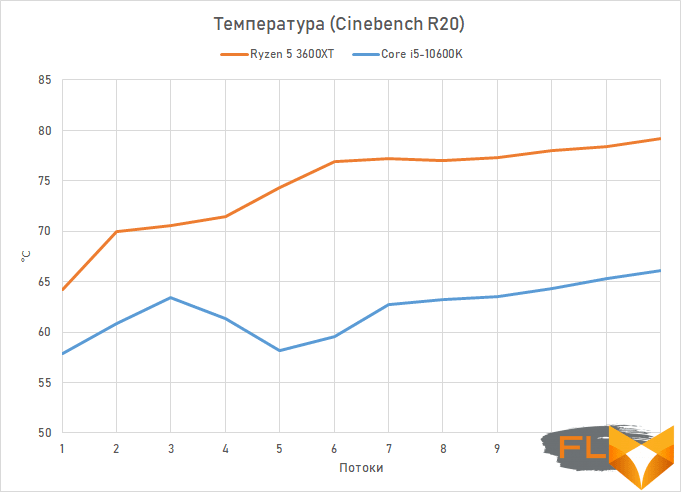
Oddly enough, the Core i5-10600K is a significantly cooler processor compared to the Ryzen 5 3600XT. While AMD’s hexa-core heats up to almost 80 degrees under full load, the Core i5-10600K has a much more comfortable 66 degrees under the same conditions. And in general, the “blue” six-core is 10-15 degrees colder in any situation. This, by the way, gives users of Intel processors a wider choice of suitable coolers: the Core i5-10600K does not need any outstanding cooling systems, which is clearly not the case with the Ryzen 5 3600XT.
⇡#Overclocking
Processors of the latest generations overclock worse and worse, as manufacturers in the pursuit of performance are trying to squeeze everything possible out of silicon. And it often turns out that overclocking in its classical sense, as an increase in the processor frequency above the nominal values, loses any expediency. At least when it comes to older processors.
But in the case of the Core i5-10600K and Ryzen 5 3600XT, the situation promises to be a little different. The Core i5-10600K may be of interest for overclocking due to the fact that its passport frequencies are lower than the frequencies of the flagship Comet Lake, which means that it has some margin. The Ryzen 5 3600XT is attracting attention in that AMD claims some improvements in the technological process for it compared to previous carriers of the Zen 2 architecture. with improved transistor parameters, which translates into lower operating voltages, lower leakage currents and higher operating frequencies.
Looking ahead, let’s say that neither the Core i5-10600K nor the Ryzen 5 3600XT set any outstanding overclocking records, but at least their overclocking still brings some result and does not look like marking time. We conducted experiments on overclocking processors without resorting to any extreme cooling systems, and used such settings that ordinary users can choose for constant use. Cooling was carried out by a Noctua NH-U14S air cooler.
Under such conditions, the Ryzen 5 3600XT processor overclocked to 4.4 GHz without much difficulty. For a representative of the Ryzen family, this is a good result. The six-core Ryzen that we visited before did not take such a frequency, stopping 100-200 MHz before it. In the case of the Ryzen 5 3600XT, reaching 4.4 GHz did not even require “unscrewing” the supply voltage: the processor worked absolutely stable even at 1.25 V with the Load-Level Calibration function enabled.
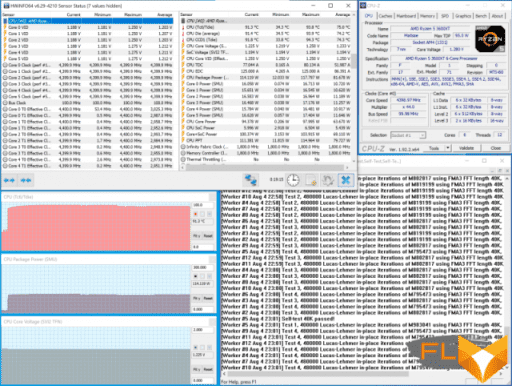
The temperature at the same time reached 94 degrees in the stress test, but, as shown above, the Ryzen 5 3600XT is a rather hot “stone”, so you just need to put up with such temperature monitoring readings. But in the end, we get a frequency on a permanent basis, which in the nominal mode is available to the processor only when one, two or three cores are loaded. And which is 200 MHz higher than the frequency of the Ryzen 5 3600XT at full load.
However, overclocking the Core i5-10600K is in any case a more productive activity. This processor overclocked to 4.9 GHz, however, with some reservations. So, in order to avoid its overheating when working with AVX instructions, a corrective delta had to be used, and the frequency when accessing AVX commands was reduced to 4.8 GHz. Nevertheless, this is still a meaningful overclocking, which brings the processor to a frequency higher than the nominal one even under low-threaded load, and at full load it allows you to get a 300-MHz advantage.
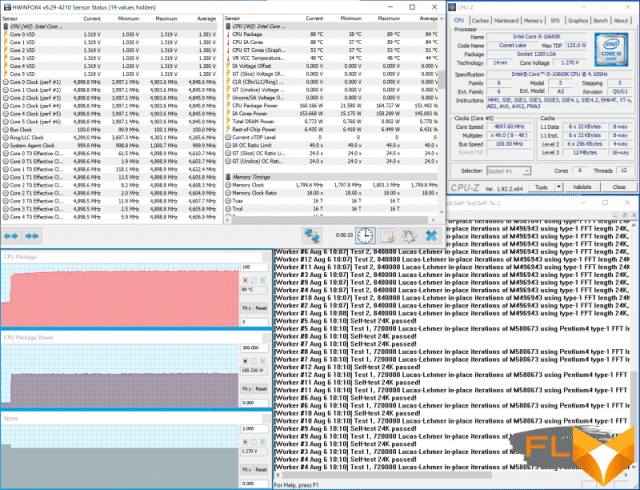
Stability in this state was achieved at a voltage of 1.4 V using the third level of Load-Line Calibration, which leaves room for some reduction in voltage with an increase in the current supplying the processor. The temperature in the stress test Prime95 29.8 did not exceed 90 degrees.
It turns out that in terms of overclocking potential, the Core i5-10600K looks a little better against the background of the Ryzen 5 3600XT. With the help of overclocking, it is possible to accelerate it by 9%, while the overclocking of the AMD processor is only 5% (if we use the CPU frequency at full load as a reference point). In the future, we will additionally evaluate the effect of overclocking in deployed tests.
⇡#Description of test systems and testing methodology
The main heroes of today’s study are the new six-core Core i5-10600K and Ryzen 5 3600XT. However, not only they took part in the tests (in the nominal mode and in overclocking), but also a number of other processors, which allow us to get an idea of the position of the main characters in the existing hierarchy. In addition to these, we also tested older six-core CPUs, and more powerful processors with eight cores, and even the flagship Core i9 and Ryzen 9.
The full list of components that took part in the test is as follows:
- Processors:
- AMD Ryzen 9 3900XT (Matisse, 12 cores + SMT, 3.8-4.7GHz, 64MB L3);
- AMD Ryzen 7 3800XT (Matisse, 8 cores + SMT, 3.9-4.7GHz, 32MB L3);
- AMD Ryzen 7 3600XT (Matisse, 6 cores + SMT, 3.8-4.4GHz, 32MB L3);
- AMD Ryzen 7 3600X (Matisse, 6 cores + SMT, 3.8-4.5GHz, 32MB L3);
- Intel Core i9-10900K (Comet Lake, 10 cores + HT, 3.7-5.3GHz, 20MB L3);
- Intel Core i9-9900K (Coffee Lake Refresh, 8 cores + HT, 3.6-5.0 GHz, 16MB L3);
- Intel Core i7-10700K (Comet Lake, 8 cores + HT, 3.8-5.1GHz, 16MB L3);
- Intel Core i7-9700K (Coffee Lake Refresh, 8 cores, 3.6-4.9GHz, 12MB L3);
- Intel Core i5-10600K (Comet Lake, 6 cores + HT, 4.1-4.8 GHz, 12MB L3);
- Intel Core i5-9600K (Coffee Lake Refresh, 6 cores, 3.7-4.6GHz, 9MB L3).
- CPU cooler: Noctua NH-U14S.
- Motherboards:
- ASRock X570 Taichi (Socket AM4, AMD X570);
- ASRock Z390 Taichi (LGA1151v2, Intel Z390);
- ASUS ROG Maximus XII Hero (Wi-Fi) (LGA1200, Intel Z490).
- Memory: 2 x 8GB DDR4-3600 SDRAM, 16-16-16-36 (G.Skill Trident Z RGB F4-3600C16D-16GTZR).
- Video Card: NVIDIA GeForce RTX 2080 Ti (TU102, 1350/14000MHz, 11GB GDDR6 352-bit).
- Disk subsystem: Samsung 970 EVO Plus 2TB (MZ-V7S2T0BW).
- Power supply: Thermaltake Toughpower DPS G RGB 1000W Titanium (80 Plus Titanium, 1000W).
All compared processors were tested with the settings accepted by the motherboard manufacturers “by default”. This means that for Intel platforms, the power consumption limits indicated in the specifications are ignored, and instead the maximum possible frequencies are used in order to obtain maximum performance. The vast majority of users operate processors in this mode, since enabling heat dissipation and power consumption limits in most cases requires special BIOS settings. The same goes for AMD processors. As it turned out recently, a large number of Socket AM4 motherboards deliberately distort the telemetry information transmitted to the processors in order to achieve higher operating frequencies from them, which formally go beyond the modes defined by the specifications.
All compared processors were tested with memory operating in DDR4-3600 mode with XMP timing settings.
Testing was performed on the Microsoft Windows 10 Pro (v2004) Build 19041.208 operating system using the following driver set:
- AMD Chipset Driver 2.07.14.327;
- Intel Chipset Driver 10.1.18295.8201;
- NVIDIA GeForce 451.67 Driver.
Description of the tools used to measure computing performance:
Comprehensive benchmarks:
- Futuremark PCMark 10 Professional Edition 2.1.2177 – testing in Essentials scenarios (typical work of the average user: launching applications, surfing the Internet, video conferencing), Productivity (office work with a word processor and spreadsheets), Digital Content Creation (creating a digital content: photo editing, non-linear video editing, rendering and visualization of 3D models).
- 3DMark Professional Edition 2.11.6846 – testing in the Time Spy Extreme 1.0 scene.
Applications:
- 7-zip 19.00 – archiving speed testing. The time taken by the archiver to compress a directory with various files with a total volume of 3.1 GB is measured. Uses LZMA2 algorithm and maximum compression ratio.
- Adobe Photoshop 2020 21.2.1 – Graphics performance testing. The average execution time of the Puget Systems Adobe Photoshop CC Benchmark 18.10 test script, which simulates the typical processing of an image taken by a digital camera, is measured.
- Adobe Photoshop Lightroom Classic 9.3 – performance test for batch processing of a series of RAW images. The test scenario includes post-processing and export to JPEG at a resolution of 1920 × 1080 and a maximum quality of two hundred 16-megapixel RAW images taken with a Fujifilm X-T1 digital camera.
- Adobe Premiere Pro 2020 14.3.1 – Non-linear video editing performance test. Measures rendering time to YouTube 4K for a project containing HDV 2160p30 footage with various effects applied.
- Blender 2.83.3 – testing the speed of the final rendering in one of the popular free packages for creating three-dimensional graphics. The duration of building the final model pavillon_barcelona_v1.2 from Blender Benchmark is measured.
- Corona 1.3 – testing rendering speed using the same-named renderer. The standard application Corona 1.3 Benchmark is used to measure performance.
- Microsoft Visual Studio 2017 (15.9.25) – compile time measurement of a large MSVC project – Blender 2.79b professional 3D package.
- SVT-AV1 v0.8.4 – testing the speed of video transcoding to the promising AV1 format. Performance is measured using a raw 1080p@50FPS AVC video file with a bitrate of about 30 Mbps.
- Topaz Video Enhance AI v1.3.8 – performance testing in an AI-based program to improve video detail. The test uses the original video at 640×360 resolution, which is scaled up twice using the Theia-Detail model: UE, P.
- V-Ray 4.10.03 – testing the performance of a popular rendering system using the standard V-Ray Benchmark Next application.
- x265 3.2+9 10bpp – testing the speed of video transcoding to H.265/HEVC format. To evaluate performance, we use the original 2160p@24FPS AVC video file with a bitrate of about 42 Mbps.
Games:
- Assassin’s Creed Odyssey. Resolution 1920 × 1080: Graphics Quality = Ultra High. Resolution 2560 × 1440: Graphics Quality = Ultra High.
- Civilization VI: Gathering Storm. Resolution 1920×1080: DirectX 12, MSAA=4x, Performance Impact=Ultra, Memory Impact=Ultra. Resolution 2560 × 1440: DirectX 12, MSAA = 4x, Performance Impact = Ultra, Memory Impact = Ultra.
- Far Cry 5. 1920 × 1080 resolution: Graphics Quality = Ultra, HD Textures = On, Anti-Aliasing = TAA, Motion Blur = On. Resolution 2560 × 1440: Graphics Quality = Ultra, Anti-Aliasing = Off, Motion Blur = On.
- Hitman 2. 1920 × 1080 resolution: DirectX 12, Super Sampling = 1.0, Level of Detail = Ultra, Anti-Aliasing = FXAA, Texture Quality = High, Texture Filter = Anisotropic 16x, SSAO = On, Shadow Maps = Ultra , Shadow Resolution = High. Resolution 2560 × 1440: DirectX 12, Super Sampling = 1.0, Level of Detail = Ultra, Anti-Aliasing = FXAA, Texture Quality = High, Texture Filter = Anisotropic 16x, SSAO = On, Shadow Maps = Ultra, Shadow Resolution = High.
- Shadow of the Tomb Raider. Resolution 1920×1080: DirectX12, Preset=Highest, Anti-Aliasing=TAA. Resolution 2560 × 1440: DirectX12, Preset = Highest, Anti-Aliasing = Off.
- Total War: Three Kingdoms. Resolution 1920 × 1080: DirectX 12, Quality = Ultra, Unit Size = Extreme. Resolution 2560 × 1440: DirectX 12, Quality = Ultra, Unit Size = Extreme.
- World War Z. 1920 × 1080 resolution: DirectX11, Visual Quality Preset = Ultra. Resolution 2560 × 1440: DirectX11, Visual Quality Preset = Ultra.
In all gaming tests, the results are the average number of frames per second, as well as the 0.01-quantile (first percentile) for FPS values. The use of the 0.01-quantile instead of the minimum FPS is due to the desire to clean up the results from random performance failures that were provoked by reasons not directly related to the operation of the main components of the platform.
⇡#Performance in complex tests
Benchmark PCMark 10, which is presented by the developer as a kind of measure of performance in common tasks of a wide profile, preference is traditionally given to Intel processors. In it, the Core i5-10600K gets a higher score than the Ryzen 5 3600XT, and this situation can be seen both in the overall rating and in scenario results. However, the gap can hardly be rightly called significant: it is obvious that the modern six-core AMD and Intel are quite close in performance. Comet Lake processors have a slight advantage here for the same reasons that they look good in games: when working with the memory subsystem and during inter-core interactions, they provide lower latency.




As for the 3DMark Time Spy test, which evaluates the hypothetical gaming performance of an “ideal” engine with full support for multi-core processors and modern vector instruction sets, the advantage remains with the Core i5-10600K. The Core i5 series processors have seen a huge performance boost with the transition from the Coffee Lake Refresh design to the Comet Lake design. Thanks to the fact that Intel was not stingy and implemented support for Hyper-Threading technology in the Core i5-10600K, it received a 30 percent increase in the CPU test compared to the Core i5-9600K. AMD processors, on the other hand, had a powerful increase in performance a year earlier, during the transition from second to third generation Ryzen. The latest Ryzen 5 3600XT is only 2% better than the Ryzen 5 3600X from a year ago. And that’s why it turned out that Intel’s six-core became even a little faster in 3DMark than a competitor’s processor of the same class, although quite recently this was out of the question.

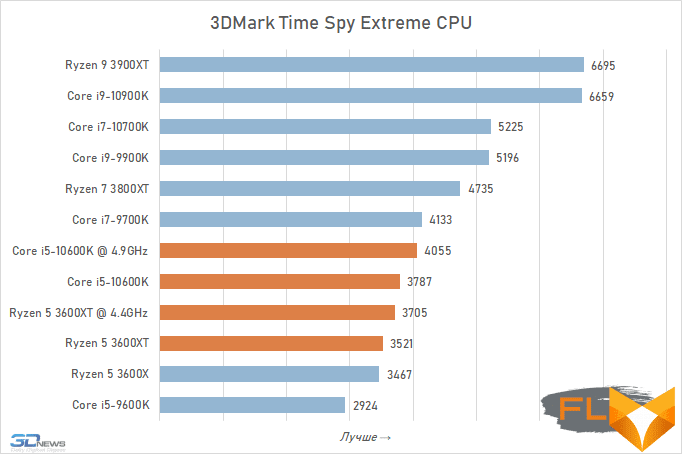
⇡#Performance in Applications
The performance picture in resource-intensive applications differs from what we observed in complex tests. This is where raw processing power comes to the fore, which is an advantage of the Zen 2 microarchitecture. Therefore, in tasks that require intensive computing work, Ryzen processors are often faster than competing proposals from the Comet Lake family.
But if we summarize all the results we obtained in ten different tasks, it turns out that in general, the Core i5-10600K is not so noticeably inferior to the Ryzen 5 3600XT in performance: the average advantage of AMD’s six-core is about 4-5%. The Ryzen 5 3600XT is clearly faster when batch processing photos in Lightroom and when compiling program code, where a giant, 32 MB L3 cache helps a lot, but, for example, when archiving or in video processing using AI, it still shows noticeably better performance Core i5-10600K.
Anyway, the updated Ryzen 5 3600XT does not look like a noticeable step forward compared to the Ryzen 5 3600X. The new Matisse Refresh didn’t impress with its specs at first, and now it only offers a 2 percent improvement in actual performance.
At the same time, the Core i5-10600K in comparison with the Core i5-9600K has increased very noticeably: the difference in performance of these processors is on average 25% in favor of the new product. Moreover, the new six-core Comet Lake almost overtook the eight-core processor from the previous generation, the Core i7-9700K, narrowing the gap between them to only 6%.
Rendering:
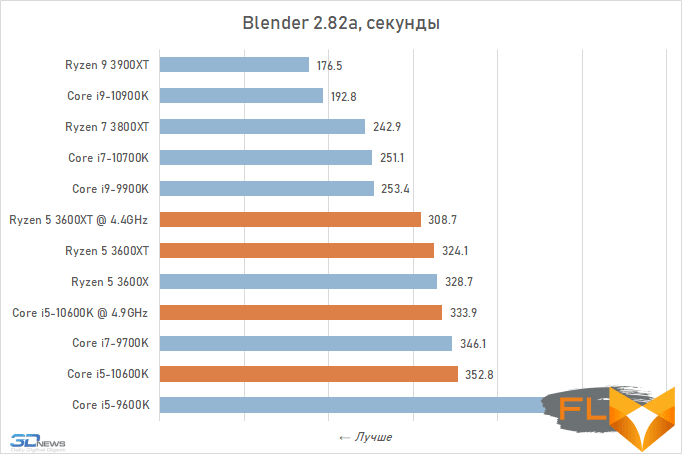
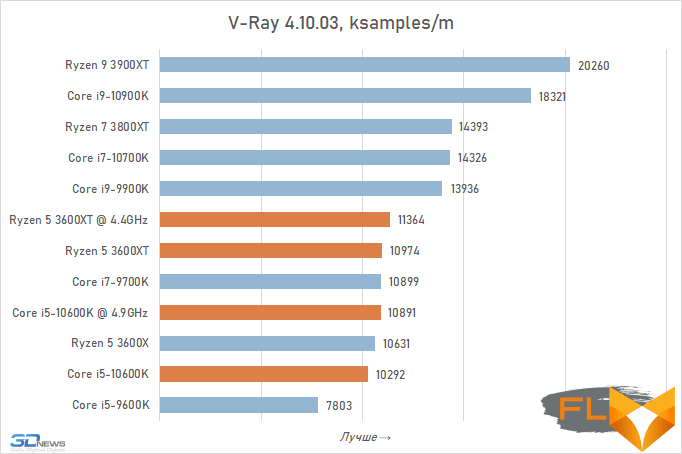
Photo processing:
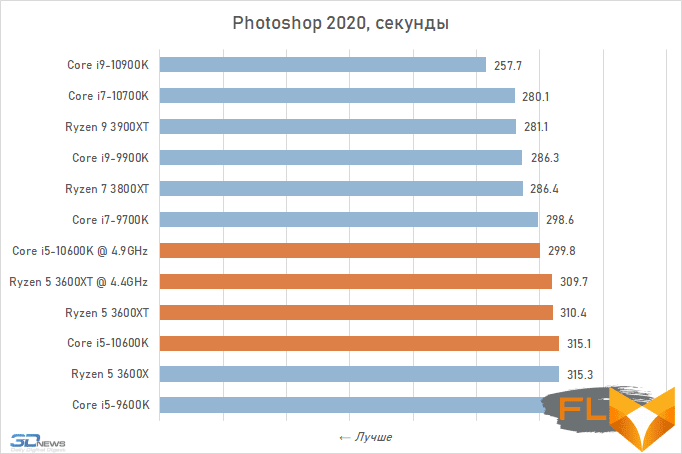
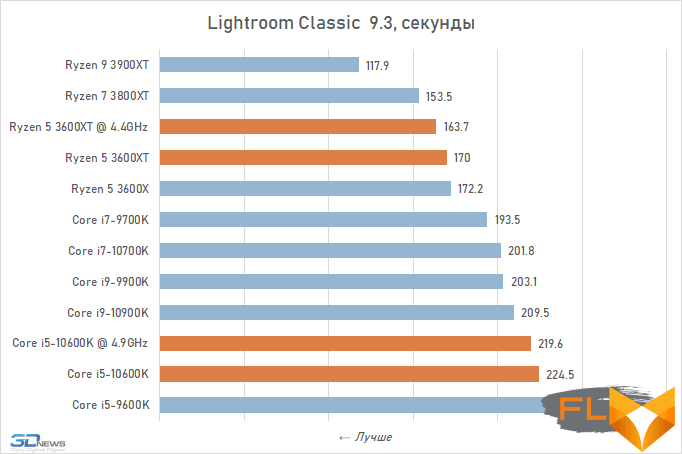
Video work:
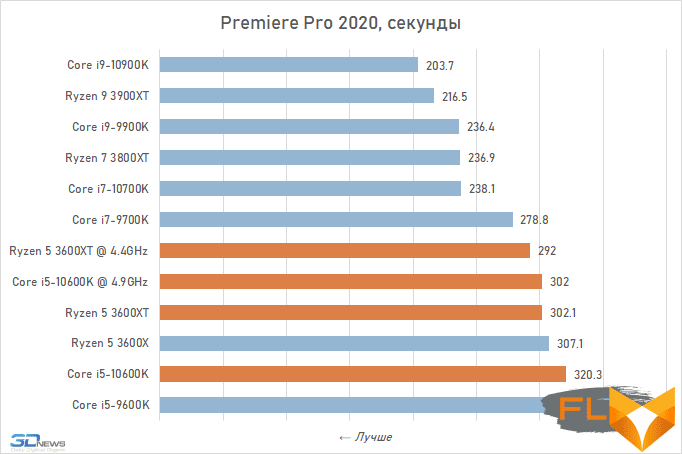
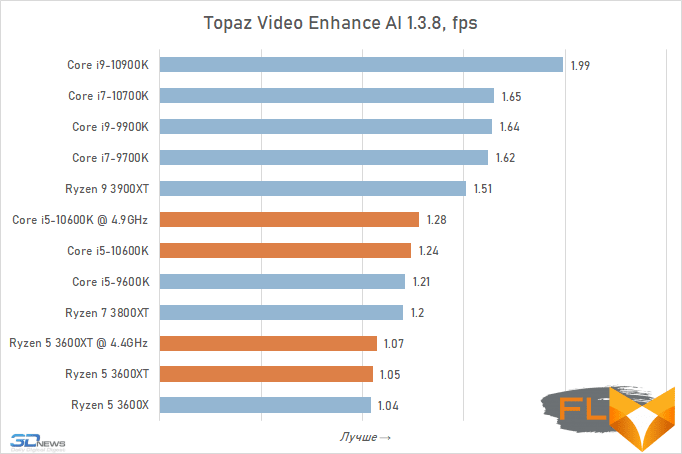
Video transcoding:
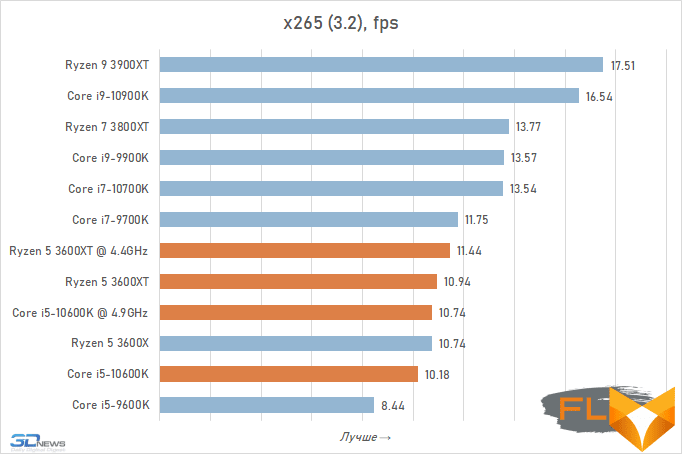
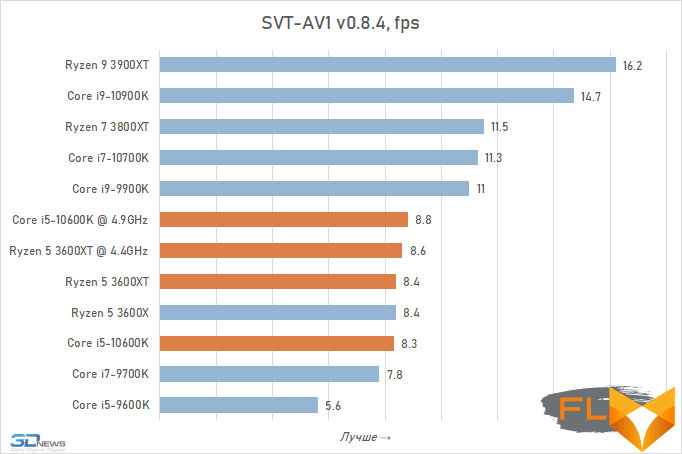
Compilation:
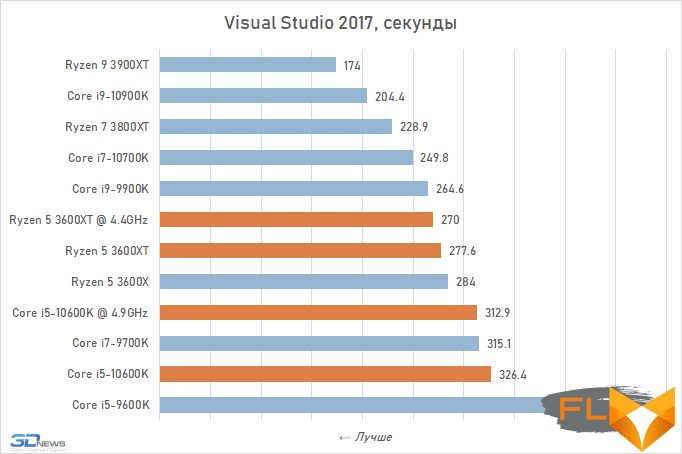
Archiving:
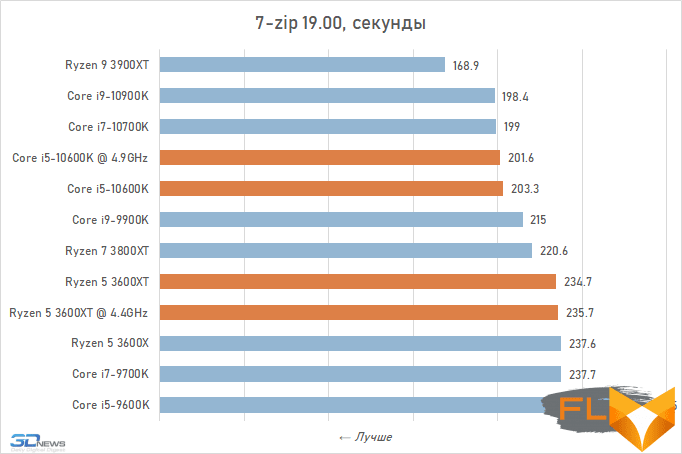
⇡#Tests in 1080p
Six-core processors are deservedly considered one of the most successful options for modern gaming systems. Games rarely require more cores, and, for example, choosing the Core i5-10600K instead of the Core i7-10700K as the basis of the assembly, the loss in average frame rate will be only about 5%, even if the fastest graphics card is used as the current one. moment a GeForce RTX 2080 Ti class solution.
At the same time, the difference in gaming performance between AMD and Intel processors is much more noticeable. The Intel platform continues to perform noticeably better under this load pattern, and ultimately the Core i5-10600K outperforms the Ryzen 5 3600XT in average FPS by a noticeable 12%, and in average minimum FPS by 13%. In this sense, AMD’s recent update to the Matisse family of processors hasn’t fixed anything: Intel solutions continue to be the preferred choice for computers aimed exclusively at gaming workloads.
In addition, Intel processors clearly benefited from the transition to the Comet Lake design and the inclusion of support for Hyper-Threading technology. The Core i5-10600K added about 3-4% to the gaming performance compared to the Core i5-9600K, and now it lags behind the Core i7-9700K in games by only 6%.
It is worth noting that overclocking does not change much in these conclusions. Both the Core i5-10600K and Ryzen 5 3600XT have fairly modest hidden frequency potential. And overclocking them in the hope of increasing the frame rate in games is completely pointless. In the best case, the increase will be only about 3%, which will not have any qualitative impact on the perception of the gameplay.
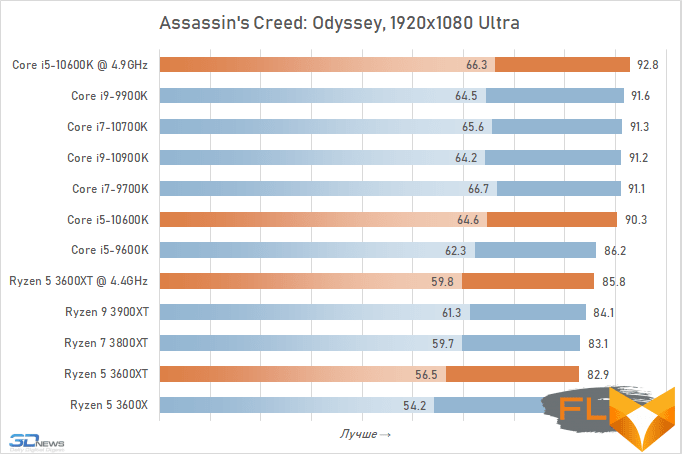
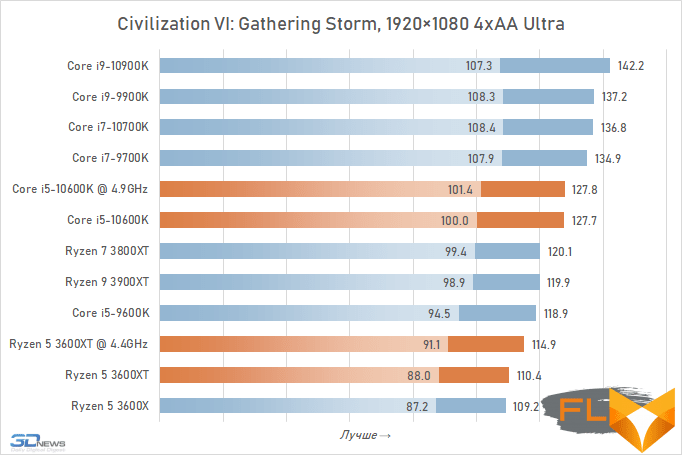

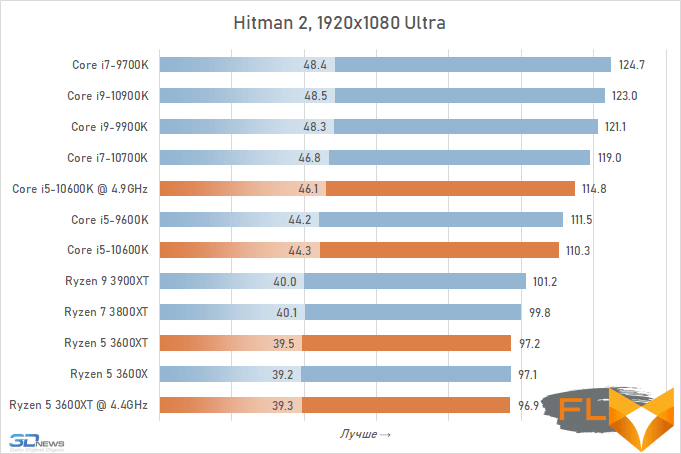
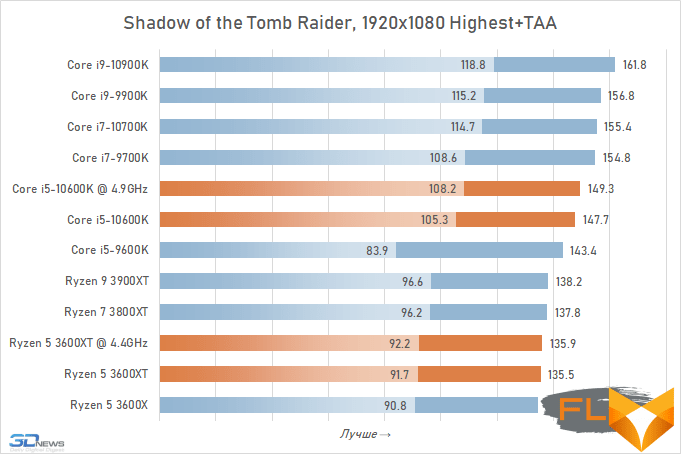
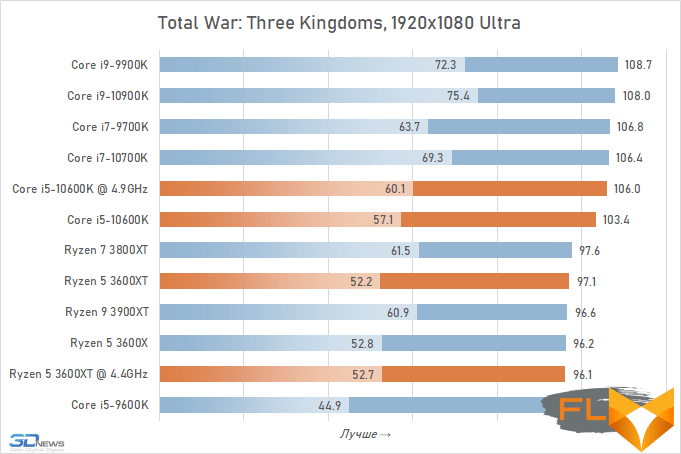
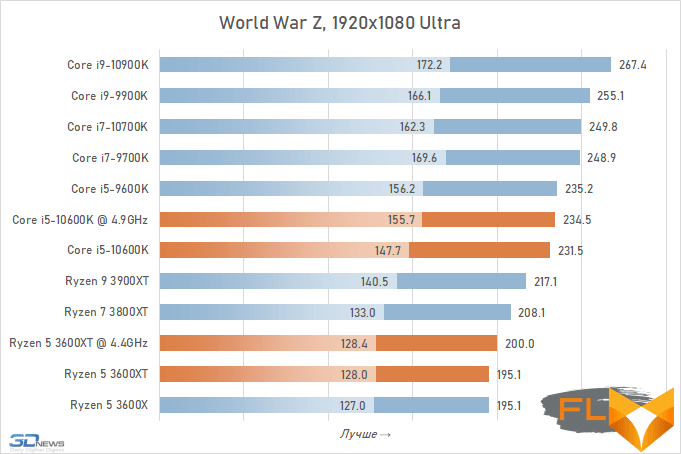
⇡#Tests in 1440p
It is curious that the increase in resolution does not completely equalize the gaming performance of processors. Even here, the Core i5-10600K scores an average of 8% higher than the Ryzen 5 3600XT. And ultimately, this means that after this summer’s update of the AMD and Intel processor lineups, the gap in gaming performance between them has widened. If earlier we could say that the Core i5-9600K looks only slightly better in games than the older six-core AMD, now that the Core i5-10600K has appeared on the market, the gaming appeal of the Ryzen 5 3600X (like the Ryzen 5 3600) has diminished. The new Ryzen 5 3600XT could not correct this situation, since in games it is almost completely similar to its predecessors.
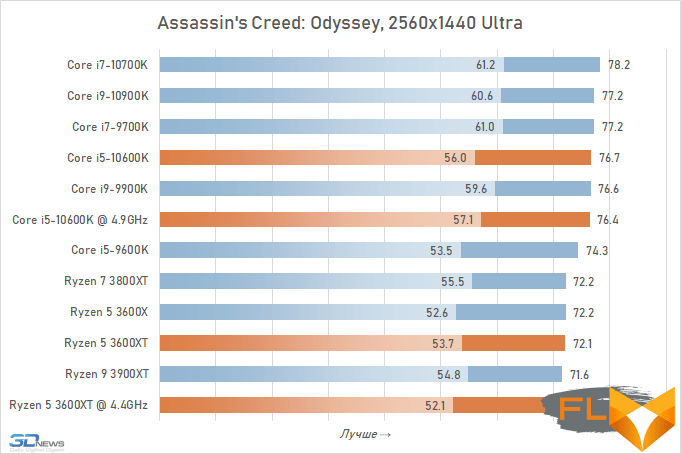
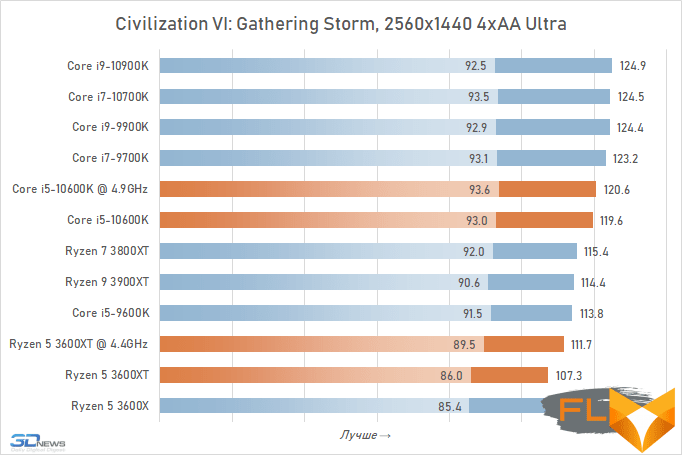
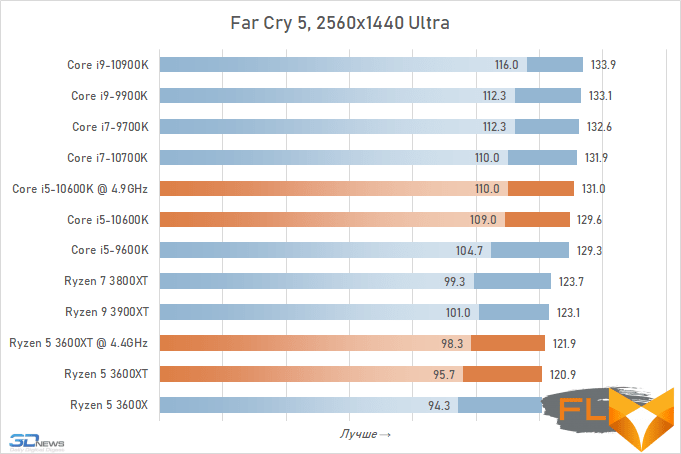
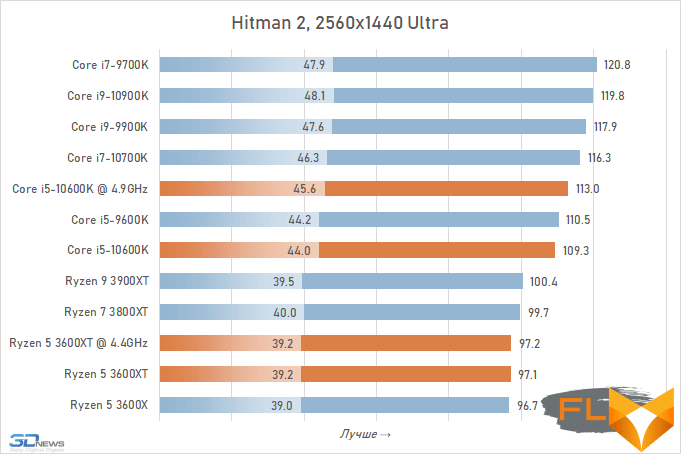
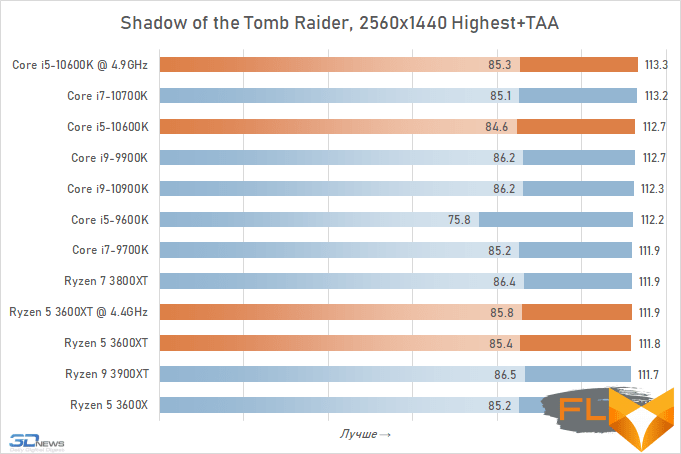
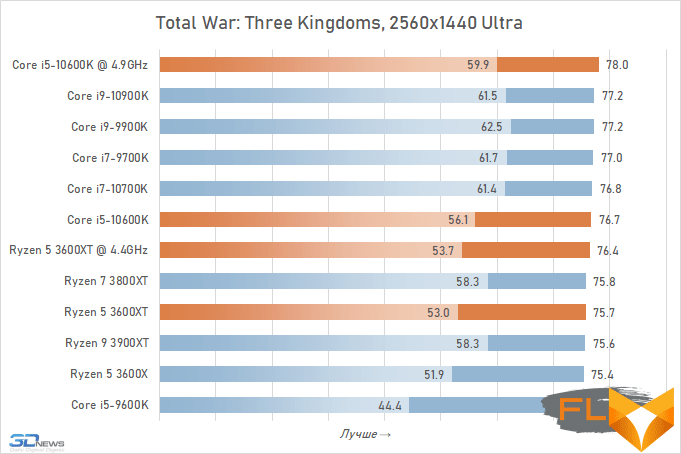
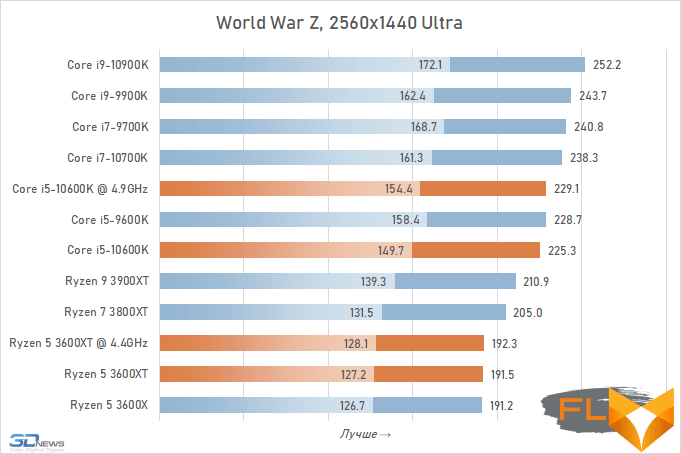
⇡#Energy Consumption
We have already said above that the Core i5-10600K and Ryzen 5 3600XT show approximately the same consumption in typical resource-intensive workloads. It remains to be seen what this converts into in terms of consumption of the complete system. The graphs below show the total consumption of the entire platform (without monitor), measured at the output of the power supply.
First of all, attention is drawn to the fact that the new six-core “gluttonous” old ones. This applies to solutions from both manufacturers: the Ryzen 5 3600XT consumes noticeably more compared to the Ryzen 5 3600X, and the Core i5-10600K compared to the Core i5-9600K. Only in the case of the Intel processor, we received a significant increase in performance as compensation, while for AMD, as follows from the tests, the performance improvement turned out to be minimal. Thus, it turns out that the 14nm Intel process in those situations when it comes to CPUs with a small number of cores is still able to “shake the old days” and does not look like a relic against the background of TSMC’s 7nm technology, which AMD relies on.
The problems of 14-nm Intel processors, which are clearly visible on the example of eight- and ten-core models, are practically not affected by the Core i5-10600K. The six-core is not at all shocking either in terms of heat dissipation or temperatures, at least if you do not overclock it. Even in Comet Lake’s most difficult test, when AVX2 instructions are used, a complete system based on the Core i5-10600K consumes only 185 watts. And this means that no special high-performance coolers and powerful power supplies are required for it.
To be fair, the same can be said for the Ryzen 5 3600XT. Although the consumption of this processor at the peak is about 20 W higher than the consumption of the older six-core Zen 2 architecture, in general, its appetites still fit within reasonable limits. What’s more, the Ryzen 5 3600XT is even slightly more economical than the Core i5-10600K. But we should not lose sight of the fact that such a rather modest power consumption is deceptive – cooling the Ryzen 5 3600XT is noticeably more difficult than the Core i5-10600K, due to the significantly smaller area of \u200b\u200bthe 7nm semiconductor crystal. Therefore, it should not be surprising that even with powerful cooling systems, the temperatures of the Ryzen 5 3600XT can be frighteningly high.
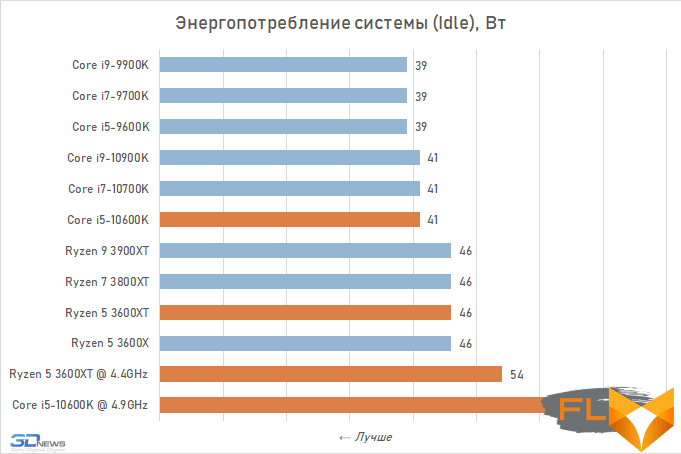
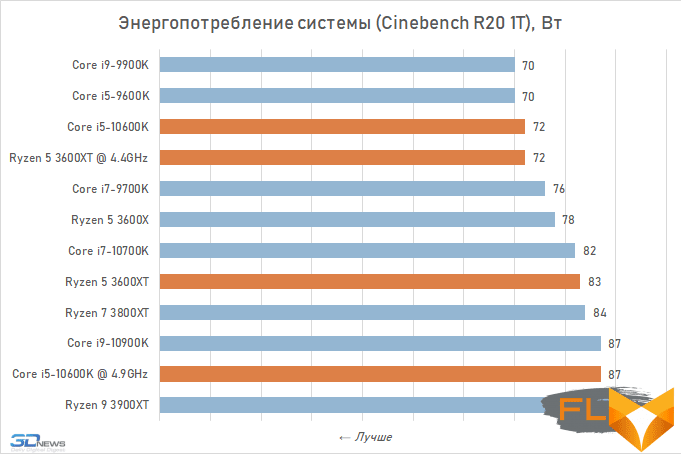
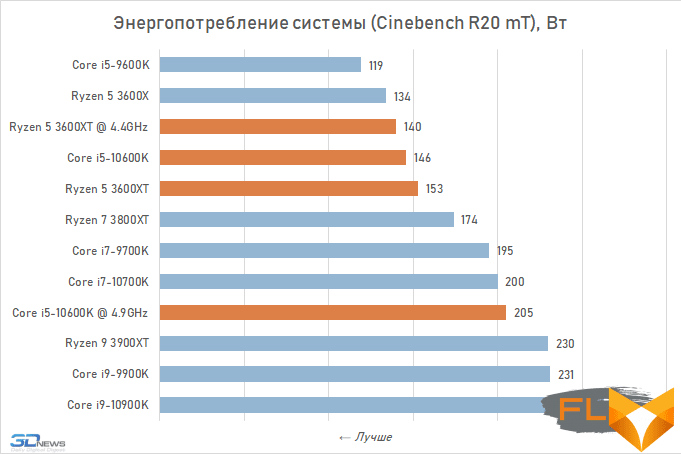
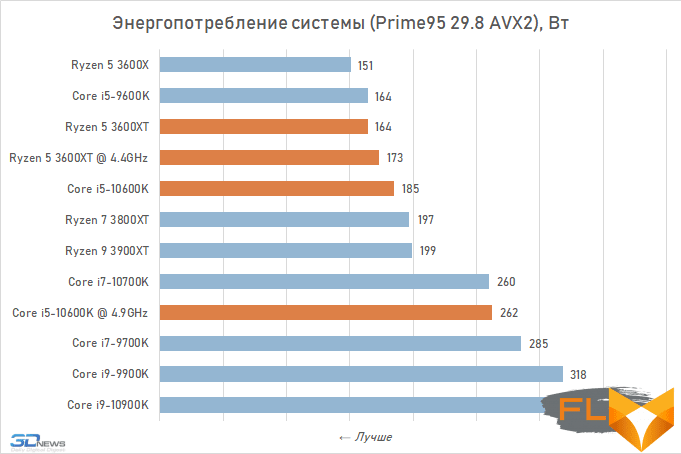
⇡#Conclusions
The older AMD Matisse Refresh processors that we have already tested did not give us much cause for optimism. And the Ryzen 5 3600XT reviewed in this article confirmed all the worst expectations: if it brings any improvements with it, it is very difficult to notice them. AMD itself talks about the optimizations made in the technical process and about increased performance, but in reality we saw something else: noticeably increased energy and thermal performance and a minimal improvement in performance. The differences in the speed of the new Ryzen 5 3600XT and the Ryzen 5 3600X, which has been on the market for a year, do not exceed a few percent, but at the same time, the operating temperatures of the new product even in the nominal mode reach 80 degrees. Based on this, the Ryzen 5 3600XT can hardly be called an attractive solution, especially since the Ryzen 5 3600X and Ryzen 5 3600 remain on the market at the same time, which have a clearly better combination of characteristics at a lower cost. The only category of users that may be interested in purchasing the Ryzen 5 3600XT is overclockers, since the frequency potential of this processor is still higher than that of its predecessors. However, we are talking here only about gaining a hundred or two megahertz, and not about some fundamentally better overclocking abilities.
The Core i5-10600K made a much better impression. Indeed, compared to its predecessor, the Core i5-9600K, it seems like a huge step forward. The new six-core processor has gained support for Hyper-Threading technology and thanks to this it has increased its performance by almost a quarter. As a result, the new representative of the Core i5 series only slightly fell short of the level of the Core i7-9700K, but bypassed the Core i7-8700K two and a half years ago in terms of performance. At the same time, the six-core Comet Lake suddenly looks neither hot nor overly gluttonous. In general, it is even colder than the competitor’s six-core processors, and its consumption is only slightly higher than that of the Ryzen 5 3600XT. The Core i5-10600K also demonstrates some potential in overclocking experiments. Enthusiasts will be able to increase its performance compared to the nominal mode, definitely more than in the case of AMD processors. And this means that among the LGA1200 processors, the Core i5-10600K is a rather interesting model.
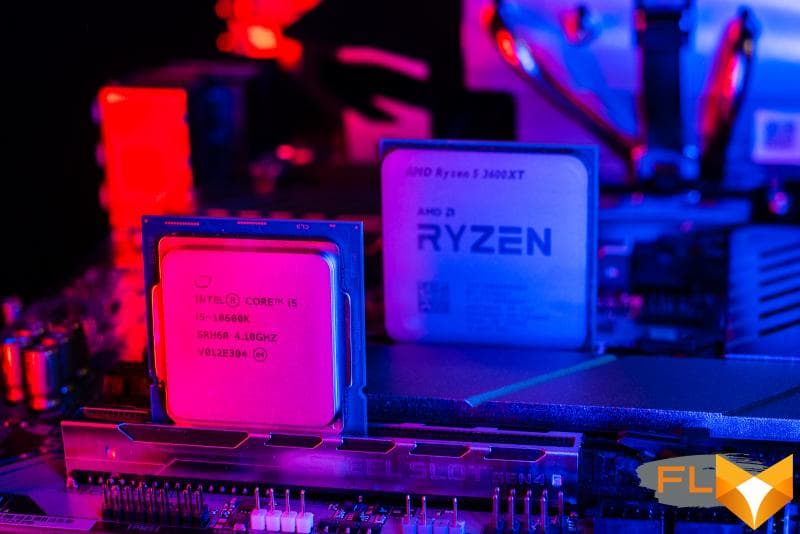
Based on the foregoing, we can conclude that in the Core i5-10600K fight against the Ryzen 5 3600XT, the “blue” processor scored more points. Indeed, in terms of actual performance, the Ryzen 5 3600XT may only offer a slight edge in some compute-intensive tasks, but it definitely loses out to the six-core Intel processor in games. And therefore, for most users, when choosing a processor with a price around $250 for a mid-range system, it would be logical to recommend the Core i5-10600K.
However, not all so simple. The fact is that AMD is able to effectively compensate for the shortcomings of its processors with a flexible pricing policy and their sale at prices much lower than the official ones. And if the price of the Ryzen 5 3600XT has not yet dropped to the point where it can be perceived as a worthy alternative to the Core i5-10600K, the real problem for sales of the six-core Comet Lake may be the Ryzen 5 3600X, which offers almost everything that and the new Ryzen 5 3600XT, but noticeably cheaper. In fact, the Ryzen 5 3600X is now about 25% cheaper than the Core i5-10600K, and this can have a significant impact on which of the six-core processors ends up in a user’s computer.
However, the “blues” still have the opportunity to present an attractive solution from all sides in the middle price segment. The retail sale has not yet received a cheaper analogue of the Core i5-10600K – devoid of the Core i5-10600KF graphics core. I would like to hope that Intel will react to the formation of its price with maximum sanity, and then we will get the most attractive option for mass gaming configurations.
